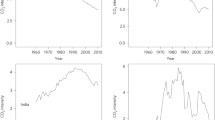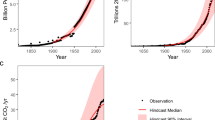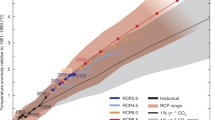Abstract
The sensitivity of future global warming to variable population growth rates is reexamined as part of an ongoing debate over the extent to which climate change should be added to the list of concerns surrounding population growth. The UN 1992 low, medium and high population projections out to the year 2150 are run through an integrated climate-economics model which allows the effect of population variability to be traced through to CO2 emissions, concentrations, warming and economic growth.
We treat separately the cases of population's role in global warming, first without and then with specified atmospheric targets. Without targets, modeled CO2 concentrations in year 2150 show great variability ranging from 600 ppm (UN low projection) to 1375 ppm (UN high projection). Such numbers suggest the potential effect of variable population growth on climate is large and that population policy options carry with them a significant, longterm, global warming mitigation component. The range of global warming achieved is not as sensitive to population because of weakened radiative absorption at high CO2 levels. With respect to targets, with low population, stabilization at 650–750 ppm is achieved with relatively modest cuts in carbon intensity. Stabilization at 350–450 ppms requires steep cuts in emissions that are only weakly affected by the full range of variable population growth rates. Stabilization at 550 ppm is thus a transitional point between these end-member roles for population. Future work needs to address cost issues which could change this assessment of the role of population with CO2 targets.
Similar content being viewed by others
References
Anderson, D. (1994). Comment on “climate and economic development,” by Nordhaus. Proceedings of the World Bank Annual Conference on Developmental Economics 1993, Wash. D.C: World Bank, 389–394.
Berner, R. A. (1990). Atmospheric carbon dioxide levels over phanerozoic time.Science, 249, 1382–1386.
Birdsall, N. (1994). Another look at population and global warming. InPopulation, environment and development: Proceedings of the United Nations expert group meeting on population, environment and development, United Nations Headquarters, 20–24 January 1992, United Nations, New York, 39–54.
Blanchet, D. (1991). Estimating the relationship between population growth and aggregate economic growth in developing countries: Methodological problems. In UN, 1991,Consequences of rapid population growth in developing countries, NY, Taylor & Francis.
Bongaarts, J. (1992). Population growth and global warming.Population and Development Review, 18(2), 299–319.
Bongaarts, J. (1994). Population policy options in the developing world.Science, 263, 771–776.
Bos, E. & Bulatao, R. A. (1990). Projecting fertility for all countries. Population, Health, and Nutrition Division/Population and Human Resources Department, Working Paper Series, No. 500. Washington, DC: The World Bank.
Broecker, W. S. (1995). Chaotic climate.Scientific American, November, 62–68.
Brower, M. C. (1994). Population complications: Understanding the population debate. Cambridge: Union of Concerned Scientists.
Engelman, R. (1994). Stabilizing the atmosphere: Population, consumption and greenhouse gases. Washington: Population Action International.
Haub, C. & Yinger, N. (1992) The UN long-range projections. Washington: Population Reference Bureau.
Holdren, J. P. (1991). Population and the energy problem.Population and Environment, 12(3), 231–255.
IPCC (1990). Climate Change: the IPCC scientific assessment. Cambridge: Cambridge University Press.
IPCC (1992). Climate change 1992: The supplementary report to the IPCC scientific assessment. Cambridge: Cambridge University Press.
IPCC (1994). Climate change 1994: Radiative forcing of climate change and an evaluation of the IPCC IS92 emissions scenarios. Cambridge: Cambridge University Press.
Lutz, W. (1993). Population and environment—what do we need more urgently: Better data, better models, or better questions? InEnvironment and population change, B. Zaba and J. Clarke (Eds), IUSSP, Derouaux Ordina Editions, Liege, Belgium, 491 pp.
MacKlellar, F. L., Lutz, W., Prinz, C. & Goujon, A. (1995). Population, households, and CO2 emissions.Population and Development Review, 21(4), 849–865.
Manabe, S. & Stouffer, R. J. (1993). Century-scale effects of increased atmospheric CO2 on the ocean-atmospheric system.Nature, 364, 215–218.
McNicoll, G. (1992). The United-Nations' long-range population projections.Population and Development Review, 18(2), 333–340.
Nakicenovic, W. D., Nordhaus, W. D., Richels, R. & Toth, F. L. (1994). Integrative assessment of mitigation, impacts, and adaptation to climate change. Laxenburg, Austria: (IIASA) International Institute for Applied Systems Analysis.
National Research Council (1986). Population growth and economic development: Policy questions. Washington, DC: National Academy Press.
Nordhaus, W. D. & Yohe, G. W. (1983). Future paths of energy and carbon dioxide emissions. InChanging climate: Report of the carbon dioxide assessment committee, Washington, DC: National Academy Press.
Nordhaus, W. D. (1992). An optimal transition path for controlling greenhouse gases.Science, 258, 1315–1319.
Nordhaus, W. D. (1994). Managing the global commons: The economics of climate change. Cambridge: The MIT Press.
O'Neill, B. C., Oppenheimer, M. & Gaffin, S. R. (1996). Measuring time in the greenhouse, in pressClimatic Change.
Oppenheimer, M. (1993). Pondering greenhouse policy.Science, 259, 1382–1383.
Poleman, T. T. (1995). Population: Past growth and future control.Population and Environment, 17(1), 19–40.
Schneider, S. (1993). Pondering greenhouse policy.Science, 259, 1381.
Siegenthaler, U. & Joos, F. (1992). Use of a simple model for studying oceanic tracer distributions and the global carbon cycle.Tellus, 44B, 186–207.
Solow, R. M. (1970). Growth theory: An exposition. New York: Oxford University Press.
United Nations (1992). Long-range world population projections. Department of International Economic and Social Affairs. New York.
Williams, R. H. (1994). Comment on “climate and economic development,” by Nordhaus. Proceedings of the World Bank Annual conference on developmental economics 1993, Wash. DC: World Bank, 381–387.
Author information
Authors and Affiliations
Rights and permissions
About this article
Cite this article
Gaffin, S.R., O'Neill, B.C. Population and global warming with and without CO2 targets. Popul Environ 18, 389–413 (1997). https://doi.org/10.1007/BF02208514
Issue Date:
DOI: https://doi.org/10.1007/BF02208514




